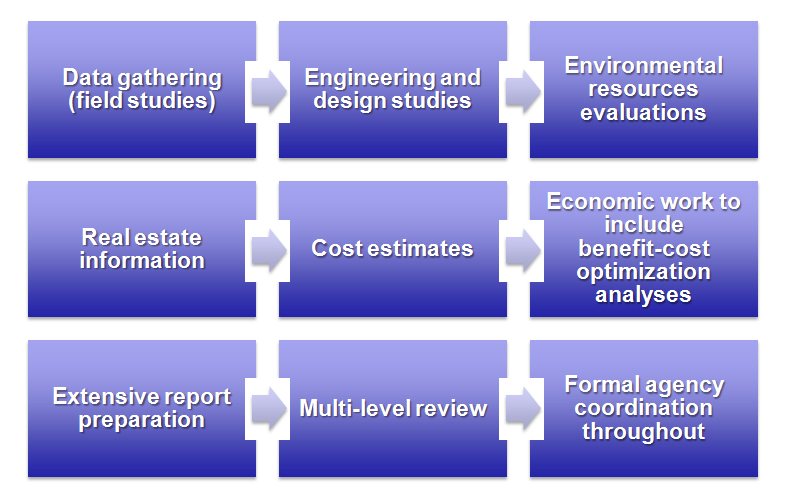Congress has delegated the Corps a number of standing authorities to study and build water resource projects for various purposes without the need for further Congressional approval.
The CAP is comprised of legislative authorities under which the secretary of the Army, acting through the chief of engineers, is authorized to plan, design and implement certain types of water resources projects. Each authority has its own program authority and strict limits on the federal contribution.
| AUTHORITY |
PROJECT PURPOSE |
Design/Implementation Phase
(Construction) Costs* |
PER PROJECT FEDERAL LIMIT |
| Section 14 |
Emergency stream bank and shoreling protections for public facilities, such as roads, bridges, hospitals, schools, and water & sewage treatment plants, that are in imminent danger of failing |
65% Federal
35% Non-Federal,
(5% minimum in cash) |
$5,000,000 |
| Section 103 |
Protection of public and private properties and facilities against damages caused by storm driven waves and currents by the construction of revetments, groins, and jetties, and may also include periodic sand replenishment |
65% Federal
35% Non-Federal |
$5,000,000 |
| Section 107 |
Improvements to navigation including dredging of channels and widening of turning basins. |
50-90% Federal
50-10% Non-Federal
(Dependent upon depth) |
$10,000,000 |
| Section 111 |
Prevention or mitigation of erosion damages to public or privately owned shores along the coastline when damages are a result of a federal navigation project. |
Cost sharing correlates to existing navigation poject |
$10,000,000 |
| Section 204 |
Regional sediment management and beneficial uses of dredged material from new or existing federal projects. |
75% Federal
25% Non-Federal |
$10,000,000 |
| Section 205 |
Local protection from flooding by non-structural alternatives (e.g. flood warning systems) or by construction of structural flood damage reduction features such as levees, channels, and dams. |
65% Federal
35% Non-Federal,
(5% minimum in cash) |
$10,000,000 |
| Section 206 |
Aquatic ecosystem restoration. |
65% Federal
35% Non-Federal |
$10,000,000 |
| Section 208 |
Local protection from flooding by channel clearing and excavation, with limited embankment construction by use of materials from the clearing operations only. |
65% Federal
35% Non-Federal |
$500,000 |
| Section 1135 |
Modifications of USACE constructed water resources projects to improve the quality of the environment.
Also, restoration projects at locations where an existing Corps project contributed to the degredation. |
75% Federal
25% Non-Federal |
$10,000,000 |
| * The first $100,000 of the feasibility phase is fully federally funded. Everything more than that amount is cost shared on a 50/50 basis between the Corps and non-federal sponsor after an FCSA is signed. |
Here's how the CAP process starts:

The initial efforts of the feasibility phase are to identify the problem and the study area, determine if there is a federal interest in proceeding with more detailed work under one of the CAP authorities, and identifying a non-federal cost-sharing sponsor.
If the above crieteria is met, the following must be done with the help of the non-federal sponsor:
• Complete a Feasibility Phase Project Management Plan
• Prepare and execute (sign) a Feasibility Cost Sharing Agreement
The purpose of the feasibility phase is to:
1. Identify problems and opportunities/objections and constraints
2. Inventory and forecast conditions(existing and future without project conditions)
3. Formulate alternative plans
4. Evaluate alternative plans
5. Compare alternative plans
6. Select the recommended plan
The following tasks are generally necessary in order to accomplish the above six steps:

Once the feasibility phase is complete, the project moves to the design/implementation (construction) phase and subsequently to the operation and maintenance phase.